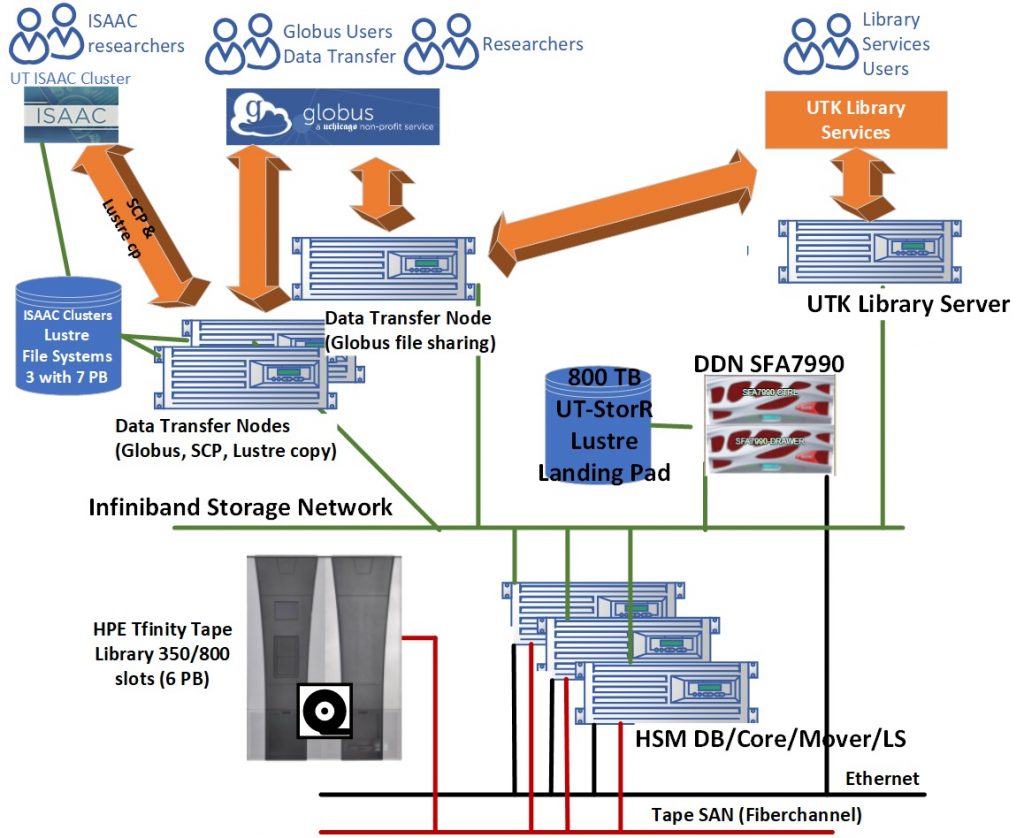UT Storage Resource for Research (UT-StorR)
UT Storage Resource for Research (UT-StorR)
The UTK Office of Innovative Technologies (OIT), in partnership with the Office of Research, Innovation, and Economic Development (ORIED), have worked together to provide the University of Tennessee Storage resource for Research (UT-StorR). This system is an archival storage system for the long-term storage of research data and data collections intended for use by UTK researchers, UTK researchers using the ISAAC HPC cluster resources, and for use by the UTK Core Facilities. UT-StorR is intended to store files from one gigabyte to sixteen terabytes in size for performance and efficiency reasons. Files put into UT-StorR should be individual large files (one gigabyte or larger) or collections of files bundled into tarballs that preserve directory structures and are themselves compressed. UT-StorR is intended for the storage of large files (not single small files nor many small files), and UT-StorR is intended for the long-term storage of research data that is not accessed on a regular basis (not for storage of research data accessed and/or used on a regular basis—daily or weekly).
UT-StorR Details
UT-StorR has an 800-terabyte Lustre file system and an 800-slot HPE Tfinity T950 automated (robot) tape library with four LTO-9 tape drives. These are integrated into the HPE Data Management Framework (DMF) software system and provide online, nearline, and offline capabilities.
Online means both the Lustre metadata (directory information) and file data are online and available in the UT-StorR Lustre file system with access to Lustre file system performance.
Nearline means the Lustre metadata is online with the UT-StorR Lustre file system, and the file data is available from the Tfinity T950 tape library. Access performance depends on the state of the tape library and LTO-9 tape read/write performance.
Offline means the Lustre metadata and file data that was once on Lustre is now only known to HPE DMF and requires DMF commands to restore access to the metadata and file data to the UT-StorR Lustre file system. The Tfinity T950 tape library has 350 slots licensed of the 800 slots available, which provides a raw capacity of 6.3 petabytes (350 x 18) and an extensible capacity of 14.4 petabytes (800 x 18) by future licensing the additional 450 slots in the tape library.
The UT-StorR resource will be available to UT researchers who use the ISAAC HPC clusters and available to the UTK Core Facilities at no additional charge to the researchers or Core Facilities. However, it is strongly encouraged for researchers and Core Facilities to purchase the LTO-9 tapes on their sponsored research projects Core Facility funds. LTO-9 tapes are approximately $175 per tape and have a capacity of 18 terabytes raw and up to 45 terabytes compressed.
A System Diagram of UT-StorR

Data Lifecycle and the UT-StorR Long-Term Archival Storage
Research data has a lifecycle when using the ISAAC HPC cluster resources (Lustre on one or more of the ISAAC clusters, on a VM in the Secure Enclave, Lustre on the Secure Enclave cluster, etc.).
A Sample HPSC Data Lifecycle

UT-StorR would be used in the research data lifecycle shown in Figure 2 where “Archive Data” is shown. The suggested research data lifecycle shown in Figure 2 was developed from the perspective that data storage indicated for “data created, reused, or collected” would reside on an ISAAC or Secure Enclave cluster in their respective Lustre file systems and that the UT-StorR archival storage system would be used to store the data where “archive data” is indicated. Then the data can be deleted from the ISAAC or Secure Enclave cluster Lustre file system. “Data sharing” would be provided by Globus from an ISAAC data transfer node used as a Globus endpoint and “Archived data sharing” would be provided by a UT-StorR data transfer node used as a Globus endpoint and accessing the UT-StorR Lustre file system.
Use Cases
The intended Use Cases for the UT-StorR long-term archival storage system include:
- Researchers who use the ISAAC campus clusters and have large amounts of primary and results research data and data collections that are no longer actively used or used very infrequently.
- UTK Core Facilities that manage instrument and other data and data collections for a community.
- In cooperation and coordination with UTK Library, the data storage by researchers, research projects, or Core Facilities to meet the data management plans of funded research projects.
Submit a Request Online
If your storage need meets any of the Use Cases mentioned previously, please submit a service request online with an OIT HPSC staff member to discuss your research data need and request access to the UT-StorR long-term archival storage system. Access to UT-StorR requires mandatory training by any researchers or research teams that need to use UT-StorR for any of the three Use Cases described previously.
The link to submit a service request is in the menu to the left, where it says “Submit HPSC Service Request.” HPSC staff will contact you to discuss your long-term archival storage need, provide training and UT-StorR overview information, and get you set up for access and use of UT-StorR resources and services.
Access
Please see the UT-StorR Access and Login webpage for information on how to access UT-StorR.
User Guide
Please see the UT-StorR User Guide webpage for information on how to use UT-StorR.

 Explore
Explore Write
Write Chat
Chat Call
Call